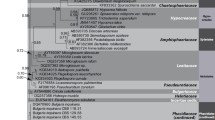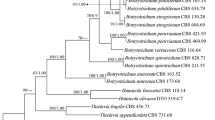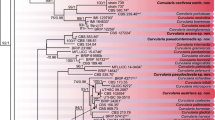Abstract
Several unidentified specimens of Bipolaris deposited in the Queensland Plant Pathology Herbarium (BRIP) that were previously recognised by Dr. John L. Alcorn as taxonomically interesting were re-examined. The morphology of conidia and conidiophores, as well as phylogenetic inference from the analyses of three loci (ITS, GAPDH and TEF1α) supported the classification of eight novel Bipolaris species, which were originally isolated from leaf spots on grasses (Poaceae).



Similar content being viewed by others
References
Acharya K, Dutta AK, Pradhan P (2011) Bipolaris sorokiniana (Sacc.) Shoem.: the most destructive wheat fungal pathogen in the warmer areas. Aust J Crop Sci 5:1064–1071
Ahmadpour A, Heidarian Z, Donyadoost-Chelan M, Javan-Nikkhah M, Tsukiboshi T (2012) A new species of Bipolaris from Iran. Mycotaxon 120:301–307
Alcorn JL (1982) New Cochliobolus and Bipolaris species. Mycotaxon 15:1–19
Alcorn JL (1990) Additions to Bipolaris, Cochliobolus and Curvularia. Mycotaxon 39:361–392
Alcorn JL (1996) Cochliobolus heliconiae sp. nov. (Ascomycota). Aust Syst Bot 9:813–817
Berbee ML, Pirseyedi M, Hubbard S (1999) Cochliobolus phylogenetics and the origin of known, highly virulent pathogens, inferred from ITS and glyceraldehyde-3-phosphate dehydrogenase gene sequences. Mycologia 91:964–977
Crous PW, Gams W, Stalpers JA, Robert V, Stegehuis G (2004) MycoBank: An online initiative to launch mycology into the 21st century. Stud Mycol 50:19–22
Crous PW, Gams W, Stalpers JA, Robert V, Stegehuis G (2004) MycoBank: An online initiative to launch mycology into the 21st century. Stud Mycol 50:19–22
Crous PW, Shivas RG, Wingfield MJ, Summerell BA, Rossman AY, Alves JL, Adams GC, Barreto RW, Bell A, Coutinho ML, Flory SL, Gates G, Grice KR, Hardy GEStJ, Kleczewski NM, Lombard L, Longa CMO, Louis-Seize G, Macedo F, Mahoney DP, Maresi G, Martin-Sanchez PM, Marvanová L, Minnis AM, Morgado LN, Noordeloos ME, Phillips AJL, Quaedvlieg W, Ryan PG, Saiz-Jimenez C, Seifert KA, Swart WJ, Tan YP, Tanney JB, Thu PQ, Videira SIR, Walker DM, Groenewald JZ (2012) Fungal Planet description sheets: 128–153. Persoonia 29:146–201
Crous PW, Wingfield MJ, Guarro J, Cheewangkoon R, van der Bank M, Swart WJ, Stchigel AM, Cano-Lira JF, Roux J, Madrid H, Damm U, Wood AR, Shuttleworth LA, Hodges CS, Munster M, de Jesús Yáñez-Morales M, Zúñiga-Estrada L, Cruywagen EM, De Hoog GS, Silvera C, Najafzadeh J, Davison EM, Davison PJN, Barrett MD, Barrett RL, Manamgoda DS, Minnis AM, Kleczewski NM, Flory SL, Castlebury LA, Clay K, Hyde KD, Maússe-Sitoe SND, Chen S, Lechat C, Hairaud M, Lesage-Meessen L, Pawłowska J, Wilk M, Śliwińska-Wyrzychowska A, Mętrak M, Wrzosek M, Pavlic-Zupanc D, Maleme HM, Slippers B, Mac Cormack WP, Archuby DI, Grünwald NJ, Tellería MT, Dueñas M, Martín MP, Marincowitz S, de Beer ZW, Perez CA, Gené J, Marin-Felix Y, Groenewald JZ (2013) Fungal Planet description sheets: 154–213. Persoonia 31:188–296
da Cunha KC, Sutton DA, Fothergill AW, Cano J, Gené J, Madrid H, De Hoog S, Crous PW, Guarro J (2012) Diversity of Bipolaris species in clinical samples in the United States and their antifungal susceptibility profiles. J Clin Microbiol 50:4061–4066
DAF Biological Collections (2016) Plant Pathology Herbarium & Insect Collection, Brisbane, Queensland, Australia. http://collections.daff.qld.gov.au. Accessed 11 May 2016
Ellis MB (1971) Dematiaceous Hyphomycetes. Commonwealth Mycological Institute, Kew
deHoog GS, Gerrits van den Ende AHG (1998) Molecular diagnostics of clinical strains of filamentous basidiomycetes. Mycoses 41:183–189
Farr DF, Rossman AY (2016) Fungal Databases, Systematic Mycology and Microbiology Laboratory, ARS, USDA. http://nt.ars-grin.gov/fungaldatabases/. Accessed 11 May 2016
Forsberg LI (1985) Foliar diseases of nursery-grown ornamental palms in Queensland. Australas Plant Pathol 14:67–71
Fröhlich J, Hyde KD, Guest DI (1997) Fungi associated with leaf spots of palms in north Queensland, Australia. Mycol Res 101:721–732
Herbarium Catalogue (2016) Royal Botanic Gardens, Kew. http://www.herbimi.info/herbimi/home.htm. Accessed 11 May 2016
Huelsenbeck JP, Ronquist F (2001) MRBAYES: Bayesian inference of phylogenetic trees. Bioinformatics 17:754–755
Iftikhar S, Asad S, Munir A, Sultan A, Ahmad I (2009) Hosts of Bipolaris sorokiniana, the major pathogen of spot blotch of wheat in Pakistan. Pak J Bot 41:1433–1436
Katoh K, Asimenos G, Toh H (2009) Multiple alignment of DNA sequences with MAFFT. Methods Mol Biol 537:39–64
Kellogg EA, Aliscioni SS, Morrone O, Pensiero J, Zuloaga F (2009) A phylogeny of Setaria (Poaceae, Panicoideae, Paniceae) and related genera based on the chloroplast gene ndhF. Int J Plant Sci 170:117–131
Madrid H, da Cunha KC, Gené J, Dijksterhuis J, Cano J, Sutton DA, Guarro J, Crous PW (2014) Novel Curvularia species from clinical specimens. Persoonia 33:48–60
Manamgoda DS, Cai L, Bahkali AH, Chukeatirote E, Hyde KD (2011) Cochliobolus: an overview and current status of species. Fungal Divers 51:3–42
Manamgoda DS, Cai L, McKenzie EHC, Crous PW, Madrid H, Chukeatirote E, Shivas RG, Tan YP, Hyde KD (2012) A phylogenetic and taxonomic re-evaluation of the Bipolaris–Cochliobolus–Curvularia complex. Fungal Divers 56:131–144
Manamgoda DS, Rossman AY, Castlebury LA, Crous PW, Madrid H, Chukeatirote E, Hyde KD (2014) The genus Bipolaris. Stud Mycol 79:221–288
Manamgoda DS, Rossman AY, Castlebury LA, Chukeatirote E, Hyde KD (2015) A taxonomic and phylogenetic re-appraisal of the genus Curvularia (Pleosporaceae): human and plant pathogens. Plytotaxa 212:175–198
Marignoni GB (1909) Micromiceti di Schio. Prima contribuzione alla flora micologica della provincia di Vicenza. Manifattura nazionale etichette, Italy
McNeill J, Barrie FR, Buck WR, Demoulin V, Greuter W, Hawksworth DL, Herendeen PS, Knapp S, Marhold K, Prado J, Prud’homme van Reine WF, Smith GE, Wiersema JH, Turland NJ (eds) (2012) International code of nomenclature for algae, fungi, and plants (Melbourne code). Regnum vegetabile 154. Koeltz Scientific Books, Königstein
Morrone O, Aagesen L, Scataglini MA, Salariato DL, Denham SS, Chemisquy MA, Sede SM, Giussani LM, Kellogg EA, Zuloaga FO (2012) Phylogeny of the Paniceae (Poaceae: Panicoideae): integrating plastid DNA sequences and morphology into a new classification. Cladistics 28:333–356
Ronquist F, Huelsenbeck JP (2003) MrBayes 3: Bayesian phylogenetic inference under mixed models. Bioinformatics 19:1572–1574
Rossman AY, Manamgoda DS, Hyde KD (2013) Proposal to conserve the name Bipolaris against Cochliobolus (Ascomycota: Pleosporales: Pleosporaceae). Taxon 62:1331–1332
Schoch CL, Crous PW, Groenewald JZ, Boehm E, Burgess TI, de Gruyter K, de Hoog G, Dixon L, Grube M, Gueidan C (2009) A class-wide phylogenetic assessment of Dothideomycetes. Stud Mycol 64:1–15
Schoch CL, Seifert KA, Huhndorf S, Robert V, Spouge JL, Levesque CA, Chen W, Bolchacova E, Voigt K, Crous PW, Miller AN (2012) Nuclear ribosomal internal transcribed spacer (ITS) region as a universal DNA barcode marker for fungi. Proc Natl Acad Sci U S A 109:6241–6246
Shivas RG (1995) New records of plant pathogens in the Kimberley region of northern Western Australia. Australas Plant Pathol 24:188–201
Shoemaker RA (1959) Nomenclature of Drechslera and Bipolaris, grass parasites segregated from ‘Helminthosporium’. Can J Bot 37:879–887
Simmonds JH (1966) Host index of plant diseases in Queensland. Queensland Department of Primary Industries, Brisbane, 111 pp
Simon BK, Alfonso Y (2011) AusGrass2. http://ausgrass2.myspecies.info/. Accessed 10 May 2016
Sivanesan A (1985) New species of Bipolaris. Trans Br Mycol Soc 84(3):403–421
Sivanesan A (1987) Graminicolous species of Bipolaris, Curvularia, Drechslera, Exserohilum and their teleomorphs. Mycol Pap 158:1–261
Stamatakis A, Alachiotis N (2010) Time and memory efficient likelihood-based tree searches on phylogenomic alignments with missing data. Bioinformatics 26:i132–i139
Stielow JB, Lévesque CA, Seifert KA, Meyer W, Iriny L, Smits D, Renfurm R, Verkley GJM, Groenewald M, Chaduli D, Lomascolo A, Welti S, Lesage-Meessen L, Favel A, Al-Hatmi AMS, Damm U, Yilmaz N, Houbraken J, Lombard L, Quaedvlieg W, Binder M, Vaas LAI, Vu D, Yurkov A, Begerow D, Roehl O, Guerreiro M, Fonseca A, Samerpitak K, van Diepeningen AD, Dolatabadi S, Moreno LF, Casaregola S, Mallet S, Jacques N, Roscini L, Egidi E, Bizet C, Garcia-Hermoso D, Martín MP, Deng S, Groenewald JZ, Boekhout T, de Beer ZW, Barnes I, Duong TA, Wingfield MJ, de Hoog GS, Crous PW, Lewis CT, Hambleton S, Moussa TAA, Al-Zahrani HS, Almaghrabi OA, Louis-Seize G, Assabgui R, McCormick W, Omer G, Dukik K, Cardinali G, Eberhardt U, de Vries M, Robert V (2015) One fungus, which genes? Development and assessment of universal primers for potential secondary fungal DNA barcodes. Persoonia 35:242–263
Strange RN, Scott PR (2005) Plant disease: a threat to global food security. Annu Rev Phytopathol 43:83–116
Subramanian CV (1983) Hyphomycetes: taxonomy and biology. Academic Press, New York
Sunder S, Singh R, Agarwal R (2014) Brown spot of rice: an overview. Ind Phytopathol 67:201–215
Tan YP, Madrid H, Crous PW, Shivas RG (2014) Johnalcornia gen. et. comb. nov., and nine new combinations in Curvularia based on molecular phylogenetic analysis. Australas Plant Pathol 43:589–603
Taylor JW, Jacobson DJ, Kroken S, Kasuga T, Geiser DM, Hibbett DS, Fisher MC (2000) Phylogenetic species recognition and species concepts in fungi. Fungal Genet Biol 31:21–32
Tsukiboshi T, Chung WH, Yoshida S (2005) Cochliobolus heveicola sp. nov. (Bipolaris heveae) causes brown stripe of bermudagrass and Zoysia grass. Mycoscience 46:17–21
Webster RD (1987) The Australian Paniceae (Poaceae). J. Cramer, Berlin
White TJ, Bruns T, Lee S, Taylor J (1990) Amplification and direct sequencing of fungal ribosomal RNA genes for phylogenetics. In: Innis MA, Gelfand DH, Sninsky JJ, White TJ (eds) PCR protocols: a guide to methods and applications. Academic Press, San Diego, pp 315–322
Acknowledgements
The authors wish to acknowledge Dr. John L. Alcorn (former curator of the BRIP) for his support, as well as his foresight in preserving all the cultures examined in this study.
Author information
Authors and Affiliations
Corresponding author
Additional information
Section Editors: Roland Kirschner and Pedro W. Crous
This article is part of the Special Issue “Biodiversity of Hyphomycetes—Special Issue in honour of Dr. Subramanian”.
Rights and permissions
About this article
Cite this article
Tan, Y.P., Crous, P.W. & Shivas, R.G. Eight novel Bipolaris species identified from John L. Alcorn’s collections at the Queensland Plant Pathology Herbarium (BRIP). Mycol Progress 15, 1203–1214 (2016). https://doi.org/10.1007/s11557-016-1240-6
Received:
Revised:
Accepted:
Published:
Issue Date:
DOI: https://doi.org/10.1007/s11557-016-1240-6




